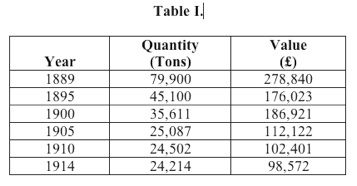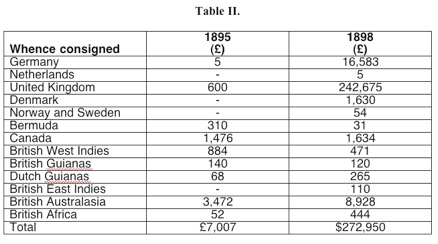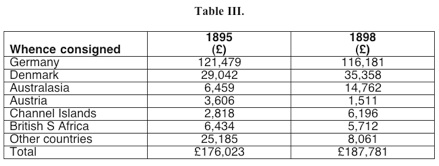Historical aspects of the Welsh slate industry
D Dylan Pritchard MA FSS
Historical aspects of the Welsh slate industry
D Dylan Pritchard MA FSS
The high water mark of the British slate export trade was - reached in 1889 with a record exportation of 79,900 tons. In that year 78 per cent. of the total number of exported slate was sent to Germany, 10 per cent. went to Australia, 5 per cent. went to Denmark, and the remaining 7 pet cent. went to other countries. These figures bring out the predominant importance of the German market in the export trade.
Tariff Barriers.
During the next twenty years there was a marked decline in the export trade. One of the reasons for this decline was that in the 'nineties countries began to levy duties on imported slate and these were raised from time to time. By 1910 there was a duty of 8/2 per ton on slates imported into France, 12/2½ per ton on slates imported into Switzerland; and ad valorem import duty of 20 per cent. in the United States and a similar duty of 25 per cent. in Canada. Slates were imported free into Denmark and this accounts for the stability of the Danish market. A duty of 6/6 per ton was levied on slates imported into Germany and this duty played an important part in reducing the demand for Welsh slate in that country. The Australian trade was restricted because of the heavy duties on imported slates; in 1897 slates were admitted free into New South Wales and Victoria but in the other States the duties ranged from 5 per cent. ad valorem in Western Australia to 25 per cent. ad valorem in Queensland. These import duties were in some cases prohibitive and in all cases they restricted the demand, but a more important cause of the decline in exports was the increase in the foreign production of slate; protected by tariffs slate production in many countries expanded so that they were able not only to satisfy the domestic demand for slate but also to compete successfully with Welsh slates in the foreign market.
Fall in Exports.
Table I. shows the quantity and value of British slate exported during certain years between 1889 and 1914

The above Table shows that there was a marked contraction in the export trade between 1889 and 1905. During the following nine years the volume of exports remained fairly stable, mainly because of exceptional activity in the Australian trade.
During the great building boom in the 'seventies the demand for slate was so great in this country, and prices were so high, that for the first time during the course of the century foreign producers found it profitable to send slates to this country particularly from the United States. This importation practically ceased during the prolonged building depression in the 'seventies, the demand for slate was so great in this country, and prices were so high, that for the first time during the course of this century foreign producers found it profitable to send slates to this country, particularly from the United States. This importation practically ceased during the long building depression in the ‘eighties, but foreign slate began once more to be imported in large quantities after 1895. As we have shown in previous articles the 'nineties was a period of great building activity and there was a great demand for all kinds of building materials. In order to maintain the priority of slate as a roofing material it was of fundamental importance to the British slate industry that it should adapt its volume of production as quickly as possibly to the increasing demand. It failed to do so, partly because of the two great industrial disputes at the Penrhyn Quarries; the first lasted for 270 working days, from September 1896, to 19 August 1897; the second strike lasted till three whole year's, 1900 to I903. The temporary closing down of' the largest slate concern in the world led to a contraction in the amount of slate produced and for several years the demand was greatly in excess of the supply.
Penrhyn Strikes.
The Penrhyn strikes. although they involved only a comparatively small number of workmen in one of Britain’s minor industries, raise an important issue which has hitherto been sadly neglected by both masters and men - the effect of industrial strife upon industries. The long-period repercussion of prolonged disputes upon the economic health of industries, particularly decaying industries, provides us with an industrial problem which merits far greater attention both from professional economists and from practical business men than it has received in the past. The Editor of the American Engineering and Mining Journal wrote as follows in 1898: “The most notable point in the American slate trade at the present time is the rapid growth in export business. A few years ago this was of too small a value to be considered, but at present it is the most prominent feature of our trade. An opportunity for the introduction of our slates abroad was given by the strike of the Welsh quarrymen and the long suspension of work which followed. Advantage was taken of the opening, and a foothold has been secured, which can very probably be retained."
Equally significant is the following extract from the Eighteenth Annual Report of the United States Geological Survey for 1896: “If he (slate) industry as a whole has done exceedingly well considering the persistence off hard times. This could not have been the case had it not been for the appearance of what to all practical purposes is a new feature in the slate industry, namely, the export trade. Attention was attracted to the export movement in the early part of the year but its activity increased until in July some notably large shipments were made to England, Germany, and other countries. Much of the slate sent to England was shipped to Australia and South Africa. This roundabout way of reaching the customers in the last-named countries has been freely discussed in some of the trade journals, and the advisability of dealing direct with the feign users of slate is so apparent that it is not unreasonable to look for a re- adjustment of trade relations by which so much unnecessary transportation of the slate may be avoided. Exportation has not been confined to roofing slate, but have included blackboards in notable quantity and to some extent other milled products.”
“The cause of this rather sudden advance in exportation is in part the labour troubles and strikes among the slate quarrymen of Wales. As a result of partial suspension of work at the Welsh quarries and their consequent inability to fill orders, the United States consuls in foreign parts were in a few instances called upon early in 1896 to furnish lists of United States slate exporters. As a result, negotiations with American producers were soon under way, agents being sent abroad to receive orders, while foreign purchasers from England, Wales, and Germany made their appearance in our own slate markets. Our slate seems to have given satisfaction abroad, and the trouble at the Welsh quarries have given producers in this country such an opportunity to display their products and secure trade as might have been much longer withheld under normal conditions. It is to be hoped that the trade thus secured by reason of temporary conditions that be held by virtue of the quality of our product and the business enterprise and sagacity of our producers."
''Some difficulty with steamship companies on the question of privilege to ship slate in bulk rather than in crates was at first experienced, but this was finally overcome. The expense of crating was a very serious item and had been almost prohibitive to exportation so that the advantage of shipment in bulk is one of considerable moment.''
In the United States Geological Survey Annual Report for 1897 we learn that in that year the production of roofing slates in the United States exceeded 1,000,000 squares for the first time, and it is stated in it that the brisk state of the slate trade was attributable to the expanding export trade and not to increased domestic consumption. “The strike among the workmen of the large slate quarries in Wales has at last, after months of rather bitter feeling, been settled to the satisfaction of employers and employees. This labour difficulty was one of the causes which led to the exportation of American slate, which was needed abroad to supply what had previously been largely forthcoming from the Welsh quarries. Of course the question naturally arises as to whether United States producers can hold the foreign trade they have gained now that the Welsh quarries are again productive. It is generally believed among American slate producers that this trade can be retained as the American slate is, on the whole, looked upon with favour abroad and much effort has been shown in efforts to popularize our products. The best evidence that the foreign exportation of slates may be regarded as a permanently established practice is that the American Slate Mart and Wharf Company, Limited, of ~London England, capital £100,000, was incorporated on September 13, 1897. The object of this company is to “establish, foster and develop the American slate trade in Britain and on the continent of Europe, in all its branches, by the importation of slates from the United States,” etc. Mr. William S Iles, of London is the head of the new concern, and with him are associated a number of well-known English capitalists. Mr. Samuel Keat of Pen Argyl, Pennsylvania, is a stock holder and also the sole representative of the company in this country.”
Growth of the U. S. Export Trade.
Table II gives the value of exports of slates from the United States to different parts of the world in 1895 and 1898.

Table II shows how rapidly the American export trade grew; in 1898 slate exports were nearly forty times greater in value than in 1895. In the later year the value of American exports to this country did not fall far short of the total British slate exports in the record year of 1889. American slates to the value of nearly £1,000,000 were imported in 1898 and the increase between 1895 and 1898 in the exportation of American slates to some of the more important foreign outlets for the British product - Germany, Denmark, and Australia - is also particularly significant.
Table III shows the value of British slate exported to different markets in the same two years, 1895 and 1898.

British exports increased slightly in value between 1895 and 1898 but it is certain that this increase would have been much greater were it not for the slate famine in the home market occasioned by a reduction in slate production, due to the Penrhyn strikes, at a time when the building trade was becoming increasingly brisker.
The German Market.
The repercussions of the Penrhyn strikes upon the slate export trade will now be studied from another angle- its effect upon the German market, which had been by far the most important outlet for British slates ever since the late 'sixties. This can be done by studying the reports on the trade of Hamburg, as given in the Annual Series of Diplomatic and Consular Reports on Trade and Finance during the time of the great Penrhyn dispute, 1900 to 1903. Hamburg had long been one of the great centres of the continental slate trade and had a widespread reputation as a favourable and cheap emporium for bulky goods destined for the interior.
In the Report for 1900 we learn that "the import of slates which has for a number of years figured prominently in the statistics of Hamburg experienced a quite unprecedented and sudden diminution. Many reasons concerned in bringing about this stagnation in trade. On the one hand, a dullness in building operations arising out of the high banking discount caused builders to limit their sphere of undertakings, and on the other hand labour difficulties at the (Penrhyn) quarries had a prejudicial effect, inasmuch as under such circumstances, an opportunity was offered to a German product, viz., enamelled cement tile slates to come forward as a substitute for British slates ; and this product on being tried has proved equally durable besides being cheaper. An increasing demand amongst customers has indeed become apparent, to the prejudice of British slates, and the outlook for future recovery is not encouraging. For when once another product has obtained a footing in the market there is much danger that a further outfall of imports from Wales will be experienced. The interest of Welsh clippers will likewise be affected thereby, as they will lose the benefit of the good freights which are always available both to and fro Hamburg for tonnage of their size." The report for 1901 states : "A further shrinking of the trade in slates has to be noted' The cement slate tiles are rapidly gaining ground here Welsh shippers do not lend the proper support to importers to enable them to counteract this course, having even raised their prices and unless matters before long experience a change this trade will die out here." The Report for 1903 makes even more gloomy reading : "The slate trade is steadily losing ground in this market. Whereas not many years ago a number of vessels arrived each spring from the Welsh slate ports very few cargoes are now imported at Hamburg. The high rates demanded for this article by the Welsh quarries seem to preclude importation, and if prices should continue to rise as they have done during the last few years this trade will be expected to fall off still further."
There is a moral somewhere that adorns this tale, but we will leave our moralising until next month.
Aspects of the Slate Industry 6: Foreign Relations:
part 2
Quarry Managers' Journal October 1943
First series
Second series
Foreign relations 2
Third Series
Other slate information
National archive slate records
Links

North Bangor Slate Co quarry Pennsylvania 1922